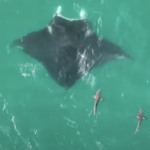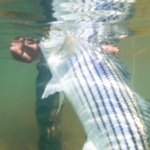
Veteran Florida Guides Concerned About False Albacore
While the ASGA team is extremely proud of the community we’re building with the Guide
(Part 3 of a 4-part series)
The stock is overfished, and overfishing is occurring… Here’s how the Commission is moving forward
A week later and we’re still decompressing from the Atlantic States Marine Fisheries Commission (ASMFC) Striped Bass Board Meeting, as well as the American Saltwater Guides Association’s (ASGA’s) testimony before the US House Natural Resources, Water Oceans and Wildlife Committee.
Both are critical to the points we’ll ultimately make in the concluding edition (Part 4) of this series.
But first, we need to summarize what went down at the Striped Bass Board meeting on Tuesday April 30th.
Addendum initiated to address “overfishing”
Yes, the Board moved to initiate an addendum to Amendment 6, which seeks to “address the overfishing status of striped bass”.
We should make a quick note here about the use of the word “overfishing” (which relates to taking too many fish out of the water) and not “overfished” (which relates to the estimated number of spawning aged fish remaining in the water dipping below a certain point).
With that in mind, what the motion did is task a “Plan Development Team” (PDT) with developing options that would get fishing mortality down to the target. It does not task them with options that would rebuild the stock, which Amendment 6 to the management plan requires when the stock dips below its spawning stock biomass threshold.
Theoretically, addressing fishing mortality, or overfishing, would rebuild the stock. But that’s not necessarily the case. More on this later.
Options for addressing overfishing
Regarding the options in the motion, the first of course is a size limit increase.
The Technical Committee (TC) actually did the analysis on this prior to last week’s meeting and detailed it in a report included in the briefing materials. The TC determined that removals will have to be reduced an estimated 17% from 2017 levels to get us to the fishing mortality target.
What they came up with is an increase from 28 to 35” along the coast and 19 to 21” on the Maryland side of the Chesapeake Bay and 20 to 22” on the Virginia side. Such regulations would have a 50% probability of achieving the 17% reduction.
The motion also tasked the PDT with providing a slot-limit option that would “prohibit harvest of fish over 40 inches”. It will be interesting to see what they come up with, but if we had to guess, it would be something in the realm of 32 to 40”. Still, we’re not sure if something like that would achieve a 17% reduction, but I suppose we’ll see.
The motion also includes an option for the mandatory use of circle-hooks when fishing bait. We should be clear here that this is merely something we should be doing. It’s very unlikely this will significantly reduce discard mortality, at least on paper, because it’s difficult to impossible for biologists to quantify the effectiveness of circle-hooks. So, don’t expect this to change the 9% discard mortality standard currently used in the model.
The motion includes an option that would allow states to use seasonal closures in their conservation equivalency proposals, as long as they achieved a 17% reduction, of course. We’re not sure of the utility of such an option, because the states could do this under the Amendment 6 conservation equivalency standard in any case. But it’s likely just a clarification that it’s up to the states should they want to control fishing effort with seasons.
Commercial vs. Recreational Reductions
Lastly, the motion requires the PDT to include an option that would apply the 17% reduction evenly to both commercial and recreational sectors, and an option to apply reductions “proportionally” based on total removals.
If you’ve been following all of this, you know that the commercial side only accounts for 10% of removals, so if the later were to come to pass, their reduction would likely be 17% of 10%. In effect, 1.7% which is, more-or-less, meaningless.
Frankly, this doesn’t sit well with us. It is our position that everyone should do their proportionate share. Commercial folks are responsible for 10% of the mortality, they should be responsible for 10% of the mortality reduction. Just as the recreational side should be responsible for 90% of the reduction. Let the commercial folks slide on this one, and it’s likely that the next thing we’ll hear is the party/charter fleet should get a pass.
The truth is, if you applied this sort of accountability argument in the context of individual states’ recreational landings, it would have an interesting impact. During the last round of reductions (Addendum IV required a 25% reduction along the coast and 20.5% in the Chesapeake), the coastal states either achieved or far exceeded their 25%. Maryland’s recreational fishery, on the other hand, didn’t even come close to achieving their required 20.5% reduction in the Bay. That sort of Chesapeake Bay overfishing likely put a big hole in the one year-class that addendum sought to protect – the 2011s–rendering at least part of that Addendum useless.
Taking the above into account, as well as the “proportional” reductions, rather than across the board ones, well then one could argue the 17% reduction should be applied to Maryland anglers proportional to their overharvest—although that wasn’t brought up, and it likely won’t be moving forward.
The point is that the standard should be across the board reductions. More on this in later posts
Addendum vs. Amendment
If you read Part 2 of this series, you know that the real threat with striped bass right now lies in the initiation of an Amendment. And this is what we had really hoped to avoid last week.
An addendum of course is just an addition to the existing Amendment 6. Remember Amendment 6 defines the overfishing and overfished reference points. Such an addendum generally takes two meetings to complete. And so, regulations can be put in place in a relatively expedited manner. In this case by the 2020 fishing season.
A new amendment would take at least two years, and thus would allow for continued overfishing during those two years. More importantly though, an Amendment would allow the board to change the goals and objectives of the fishery management plan, in this case focusing more on harvest, and less on a healthy and abundant stock. And it would most certainly open the door for the board to reassess the reference points and the management triggers established in Amendment 6.
Maryland has made no secret that it wishes to change the spawning stock biomass target and/or threshold, arguing that the Chesapeake Bay (by far the largest producer area) is less productive than it had been, and arguing the target/threshold is too difficult to reach. We should note, there is no science behind such contention, and well, it’s just not true. We’ve had four above average year classes in the last 15 years. The only thing we really need to do to rebuild to the spawning stock biomass target is to keep them alive for a bit.
All that said, Maryland saw the writing on the wall well before the meeting, and knew well they didn’t have the votes to initiate such an Amendment – at least not until action was taken to address overfishing by 2020 – because that’s what the majority of the states were demanding.
So, they moved to initiate an Amendment after the addendum is completed. That motion was tabled for discussion in August.
It may well fail in August. We certainly hope that it does. But we should play close attention to this. Because it if passes, we will have a long hard battle ahead of us to keep the current standards of what a rebuilt stock looks like in place. If Maryland succeeds in lowering that bar. It will be VERY difficult to EVER get it back up.
So, what happens next?
Over the next few months, the PDT will develop a “Draft Addendum” which includes the options laid out in the Board motion, with accompanying analysis. This will be available a week or so prior to the August 6th to 8th ASMFC meeting.
The Board will hopefully approve such Draft Addendum for public comment, perhaps with some changes during the meeting. Then, the Commission will schedule public hearings in each state, and a public comment period will be held for at least 30-days.
During ASMFC’s October 28th – 30th meeting, the Board will review the public comment received, select final measures, and consider approving the final addendum. Assuming all goes as planned, the states will implement the addendum measures in January 2020.
The public comment part of this is very important. This is where we have the chance to thoroughly express our support for particular options. So please stay tuned. We will make sure to post a schedule of such hearings as soon as it’s released. And we will most certainly help with the development of both oral and written comments should anyone need that.
On addressing overfishing and rebuilding
As mentioned in the beginning here, both staff and the Striped Bass Board made clear that the intent of the addendum is to address overfishing, not necessarily to rebuild the stock (in 10 years or less).
Trigger two in Amendment 6 is pretty clear on the requirement to do just that though:
“If the Management Board determines that the biomass has fallen below the threshold in any given year, the Board must adjust the striped bass management program to rebuild the biomass to the target level within [no more than 10 years].”
When asked about this at the meeting, ASMFC staff noted that reducing fishing mortality to the target would “theoretically” lead to rebuilding to target spawning stock biomass… at some point. But staff was clear that no analysis had been done to determine when that might happen with the fishing mortality target.
Yes, we made sure that such analysis would be done, but there is no guarantee that it will be included in the Draft Addendum. In fact, it’s unlikely that this will be included, especially if the fishing mortality rebuild value is considerably more constraining than the fishing mortality target one.
With species managed under the Magnuson Stevens Fishery Conservation and Management Act, there is a very clear mandate to rebuild the stock should it become overfished. And so there is a very clear fishing mortality rebuild level applied to a mandated federal rebuilding plan. Obviously, no such thing exists with ASMFC managed fisheries, which is just one of the reasons they are all in the crapper right now.
Yes, we understand full well that there’s a level of uncertainty involved in projecting rebuild schedules, particularly when dealing with anadromous species such as striped bass. But the way the Councils are required to deal with such uncertainty is to simply add a precautionary buffer to the rebuilding plan. We’re fairly certain that the Commission has little to no interest in doing that.
Conclusion
Striped bass is overfished and overfishing is occurring. The Commission is indeed addressing it with an Addendum, instead of a comprehensive amendment that would likely alter the entire striped bass management program – allowing for greater harvest and less availability for anglers. While we’re not out of the weeds with such an Amendment, we aren’t in crisis mode either. At least not yet.
Still, the apparent indifference toward instituting a clear rebuilding plan is concerning. There is a very real difference between “theoretically” rebuilding the stock at some undetermined point in the future, and a federal mandate to rebuild as soon as possible, not to exceed 10 years. That sort of mandate doesn’t allow the sort of discretion the Commission seems to be taking with striped bass.
Arguably, the lack of mandatory rebuilding measures, as well as the lack of annual catch limits and accountability measures is what lead to the failure of Addendum IV, which almost certainly lead us to the overfished situation we’re in right now.
If we are to have any hope of maintaining this fishery and the huge industry it supports, the way the Commission does business needs to change.
We’ll take a deeper dive into this in Part 4 of this series. Stay tuned.

While the ASGA team is extremely proud of the community we’re building with the Guide

Feature Image: A false albacore being landed off Jupiter Florida by the Cheeky Fishing team,

Feature Photo: “Best Practices for Fishing Cobia Around Manta Rays” The Florida Manta Project is

We caught this article a few days ago. Here’s the summary: Maryland striped bass commercial
We rely on our members and donations to keep fighting for a sustainable tomorrow in marine conservation.
By using this website, you agree to our use of cookies. We use cookies to provide you with a great experience and to help our website run effectively. To learn more, please review our privacy policy.
8 Responses
I really like how they seem to think this problem will fix itself it’s better to limit the availability of the species now than the alternative which is a complete collapse …again